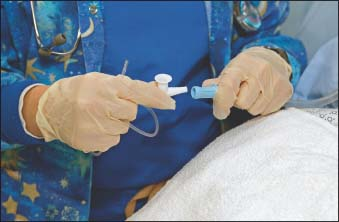Oronasopharyngeal Suction
Oronasopharyngeal suction removes secretions from the pharynx by a suction catheter inserted through the mouth or nostril. Used to maintain a patent airway, this procedure helps the patient who can’t clear his airway effectively with coughing and expectoration, such as the unconscious or severely debilitated patient. The procedure should be done as often as necessary, depending on the patient’s condition.
Because the catheter may inadvertently slip into the lower airway or esophagus, oronasopharyngeal suction is a sterile procedure that requires sterile equipment. However, clean technique may be used for a tonsil tip suction device. In fact, an alert patient can use a tonsil tip suction device himself to remove secretions.
Equipment
Wall suction or portable suction unit with connecting tubing ▪ water-soluble lubricant ▪ sterile normal saline solution ▪ disposable sterile container ▪ sterile suction catheter (a #10 to #16 French for an adult, #8 or #10 French for a child, or pediatric feeding tube for an infant) ▪ sterile gloves and personal protective equipment, as needed ▪ overbed table ▪ waterproof trash bag ▪ towel ▪ Optional: tongue blade, tonsil tip suction device, nasopharyngeal or oropharyngeal airway (optional for frequent suctioning).
A commercially prepared kit contains a sterile catheter, disposable container, and sterile gloves.
Preparation of Equipment
Before beginning, check your facility’s policy to determine whether a doctor’s order is required for oropharyngeal suctioning. Also review the patient’s blood gas or oxygen saturation values, and check vital signs. Evaluate the patient’s ability to cough and deep breathe to determine his ability to move secretions up the tracheobronchial tree. Check his history for a deviated septum, nasal polyps, nasal obstruction, traumatic injury, epistaxis, or mucosal swelling.
If no contraindications exist, gather and place the suction equipment on the patient’s overbed table or bedside stand. Position the table or stand on your preferred side of the bed to facilitate suctioning. Connect the tubing to the suctioning unit. Date and then open the bottle of normal saline solution. Open the waterproof trash bag.
Implementation
Confirm the patient’s identity using at least two patient identifiers according to your facility’s policy.1
Explain the procedure to the patient even if he’s unresponsive. Inform him that suctioning may stimulate transient coughing or gagging, but tell him that coughing helps to mobilize secretions. If he has been suctioned before, just summarize the reasons for the procedure. Reassure him throughout the procedure to minimize anxiety and fear, which can increase oxygen consumption.
Determine which nostril is more patent.
Place the patient in semi-Fowler’s or high Fowler’s position, if tolerated, to promote lung expansion and effective coughing. If the patient is unconscious, position him on his side facing you to help promote drainage of secretions.
Place a towel across the patient’s chest.
Turn on the suction from the wall or portable unit, and set the pressure according to your facility’s policy. Usually, the pressure may be set between 100 and 120 mm Hg; higher pressures cause excessive trauma without enhancing secretion removal.5
Occlude the end of the connecting tubing to check suction pressure.
Using strict sterile technique, open the suction catheter kit or the packages containing the sterile catheter, container, and gloves. Put on the gloves; consider your dominant hand sterile and your nondominant hand nonsterile.
Using your nondominant hand, pour the saline solution into the sterile container.
With your nondominant hand, place a small amount of water-soluble lubricant on the sterile area of the catheter. The lubricant is used to facilitate passage of the catheter during nasopharyngeal suctioning.
Pick up the catheter with your dominant (sterile) hand and attach it to the connecting tubing (as shown below). Use your nondominant hand to control the suction valve while your dominant hand manipulates the catheter.

Dip the catheter into the sterile normal saline solution (as shown below) to moisten the inside of the catheter.
Stay updated, free articles. Join our Telegram channel

Full access? Get Clinical Tree


Get Clinical Tree app for offline access
